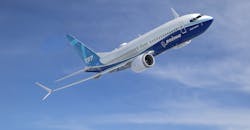Safety Reviews Keeping 737 MAX Return Uncertain
The return to regular service for the Boeing 737 MAX commercial service remains undetermined, as the Federal Aviation Administration and the European Aviation Safety Administration continue to review the flight-control software updates that are expected to correct the cause of two fatal crashes in the past year. Boeing has said it hoped to return the twin-engine aircraft to service during the fourth quarter of 2019.
Neither FAA nor EASA has indicated when its reviews will be completes. There is growing concern that EASA’s stated intention to conduct its own, separate review of the proposed revisions to the software will prolong the recertification process.
In addition to Boeing, the delay is causing disruptions to schedules for multiple carriers, including Southwest Airlines, American Airlines, Southwest Airlines, United Airlines, and RyanAir and Norwegian Air in the European market.
In a statement published by Reuters, an EASA spokeswoman sought to minimize the concern over the separate review process. “We do not at this stage have any specific concerns resulting from that assessment that would mean that we could not agree to a coordinated return to service. We are in continuous contact with both the FAA and Boeing."
The 737 MAX is Boeing’s best-selling aircraft, but it has been suspended from service worldwide since March, following the two crashes, first on Indonesia’s Lion Air in October 2018 and then on Ethiopian Airways in March 2019. A total of 346 passengers and crew members were killed in those incidents.
Boeing halted deliveries of the 737 series and reduced the production rate to 42 jets/month. Most of its production is concentrated on the 737 MAX (it has an order backlog of more than 4,600 of the 737 MAX) though it continues to produce the previous 737 Next Generation version, too.
Boeing has determined that the crashes were caused by a Maneuvering Characteristics Augmentation System (MCAS), also known as "anti-stall" software, developed to off-set a side-effect of the more fuel-efficient engines adopted for the new version of the 737: because of the engines’ larger size, the planes’ aerodynamic behavior is altered, and the MCAS is meant to counteract a stalling tendency.
Boeing’s software redesign reportedly will incorporate data from two flight-control computers rather than one.
Securing the two agencies’ clearance is not the only hurdle for Boeing to clear before the aircraft returns to service: other air-safety agencies also must approve the revisions, and the global fleet of 385 aircraft must be reprogrammed with the new software.
Beyond the return to service, Boeing also aims to resume production and deliveries of the 737 series – which it had hoped to initiate this month.
